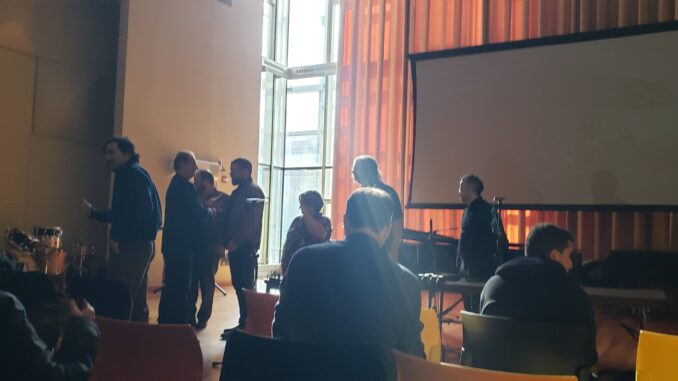
By Kiara Jones-Ford
A piano, microphone, and laptop hooked up to a sound system sit center stage as the audience members take their seats. The performer clicks something on his laptop, causing a reverberating synth to travel around the room. His voice echoes from all over as he shouts and hums into the microphone, while the piano is played across different scales, creating a soundscape reminiscent of a hypnotizing spiral.
This unique blend of music formats was part of the International Electroacoustic Music Festival held at the Buchwald Theater and Topher Recital Hall. Held biannually, the first performances were held this past weekend from Oct. 20 to Oct. 22. Directed this year by George Brunner, the festival celebrated its 33rd performance.
Electroacoustic music is a blend of two seemingly opposite forms of music to create a unique sound; it takes live acoustic instruments, such as a piano or the human voice, and is incorporated with electronic elements in what is known as a synthesizer, a program used by musicians to blend melodies together.
Each day of the festival was centered around a different theme, and the theme of Saturday, Oct. 21, was “Alumni Extraordinaire.” Former Brooklyn College graduates returned to the home of the BC Bulldogs to present different pieces of work and explain what inspired each of their pieces. Some alumni have worked on movie and television soundtracks, while others have released their own work independently. There were a total of six performances during the afternoon’s display of talent, two of which included “Studies in Turbulence” by Simon Brown and “The Ritual of the Mouse Who Devoured The World” by Nicholas R. Nelson.
Brown’s piece engaged the audience with his own synthesizing to create an interactive experience. He held up a QR code for everyone to scan, and once scanned, each phone in the room played a specific melody of synthesized pitches in harmony with a basic, pulsating beat from the main sound system played by Brown himself. The high-pitched noises were like a xylophone, only this was more electric in nature.
Brown described his work as being inspired by the elements of nature, but also a new way of interpreting the world through music; he called this musical realism. “The real study here is isomorphism: the idea that the brain reads certain stimuli as an experience,” Brown explained in the playbook. “And so, ‘Studies in Turbulence’ is a study of understanding a sonic composition as we might look at a landscape painting. We are able to see that the painting is both a landscape and a collection of brush strokes. You’ll be able to hear this piece in a similar way.”
Nelson’s work, on the other hand, takes that idea of turbulence a step further with his piece “The Ritual of the Mouse Who Devoured The World.” It was inspired by Nelson’s research of the construction of Disney World, which has unique tax breaks, land ownerships, and even laws to upkeep the over 30,000-acre theme park. To Nelson, it felt like “Disney would eventually devour the world,” which inspired the title of his piece.
Nelson’s work was a blend of different pieces of familiar Disney songs and techno beats; music that was once comforting was now distorted. In one case, the once familiar, upbeat voice that sang “Be Our Guest” in Disney’s “Beauty and the Beast” now had a lower-pitched, darker-toned voice, paired with sirens, static, and cut-offs that painted a dystopian portrait of Disney. Suddenly, the familiar whistle of “Steamboat Willie” slowly faded off with a low drone. The suspense slowly crept up on the audience, met with the duality of the charming facade of Disney and its sinister growth and monopoly.
In response to the meaning of the exact pieces he chose, Nelson said, “I chose them mostly sonically; I wanted legible words and phrases I could manipulate, such as ‘Be Our Guest.’ It felt like a good opener to the piece.”
The next Brooklyn Electroacoustic Ensemble performance will be held on Wednesday, Nov. 29, at the Topher Recital Hall, which will see more artists showcase their own distinctive styles of electroacoustical music.
